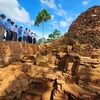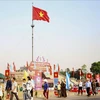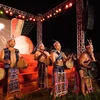The National Tourism Year 2015 has been recently kicked off in the central province of Thanh Hoa under the theme “Connecting World Heritage Sites” striving to maximise the value of Vietnam’s heritages, reported the Cong An Thanh pho Ho Chi Minh (Ho Chi Minh City Police) newspaper.
Vietnam is currently home to eight world tangible heritage sites recognised by UNESCO, the Central Sector of the Imperial Citadel of Thang Long (Hanoi), Ha Long Bay (northern Quang Ninh province), the Trang An Landscape Complex (northern Ninh Binh province), the Citadel of the Ho Dynasty (Thanh Hoa province), Phong Nha-Ke Bang National Park (central Quang Binh province), the Complex of Hue Monuments (central Thua Thien-Hue province), Hoi An Ancient Town and My Son Sanctuary (central Quang Nam province).
UNESCO said once recognised, each heritage site has an estimated original value of 500 million USD, which will increase over the time if it is well-maintained.
The honoured heritage sites are the basis of cultural and tourism services and products, contributing to socio-economic development of each locality and Vietnam as a whole, according to the Ministry of Culture, Sports and Tourism (MCST)’s Department of Cultural Heritage.
Ha Long Bay now welcomes more than 2 million tourists every year with tourism revenue of tens of millions of USD, a surge from several tens of thousands of visitors a year before it received the world’s heritage title.
About 1.76 million tourists spent their holidays in Hoi An Ancient Town in 2014, generating nearly 2.21 trillion VND (105.2 million USD) in total revenue. Meanwhile, the Phong Nha-Ke Bang National Park receives over 250,000 visitors and earns 23.6 billion VND (1.12 million USD) from tourism every year.
Boasting the Citadel of the Ho Dynasty, Thanh Hoa province attracted 4.1 million tourists in 2013 and 4.5 million in 2014, yielding respective revenues of 2.25 trillion VND (107.1 million USD) and 2.5 trillion VND (119 million USD).
Residents around the heritage sites have also enjoyed improved livelihoods by producing souvenirs and supplying tourism services.
However, Vietnam is facing major challenges in the preservation and exploitation of its heritages. Insiders have said the current ineffective utilisation of heritage values is primarily due to the overlapping management across agencies at different levels, adding that a common management mechanism is needed though each heritage site has its own identity.
Once the eight world tangible heritage sites are well connected, their value can be utilised much more effectively.
Experts underlined the role of a specific State agency in steering heritage preservation and connecting sectors, localities, businesses and local residents in the effort.
In particular, they asked the MCST to expeditiously design a coordination mechanism for State agencies to facilitate local heritage management activities.-VNA
Vietnam is currently home to eight world tangible heritage sites recognised by UNESCO, the Central Sector of the Imperial Citadel of Thang Long (Hanoi), Ha Long Bay (northern Quang Ninh province), the Trang An Landscape Complex (northern Ninh Binh province), the Citadel of the Ho Dynasty (Thanh Hoa province), Phong Nha-Ke Bang National Park (central Quang Binh province), the Complex of Hue Monuments (central Thua Thien-Hue province), Hoi An Ancient Town and My Son Sanctuary (central Quang Nam province).
UNESCO said once recognised, each heritage site has an estimated original value of 500 million USD, which will increase over the time if it is well-maintained.
The honoured heritage sites are the basis of cultural and tourism services and products, contributing to socio-economic development of each locality and Vietnam as a whole, according to the Ministry of Culture, Sports and Tourism (MCST)’s Department of Cultural Heritage.
Ha Long Bay now welcomes more than 2 million tourists every year with tourism revenue of tens of millions of USD, a surge from several tens of thousands of visitors a year before it received the world’s heritage title.
About 1.76 million tourists spent their holidays in Hoi An Ancient Town in 2014, generating nearly 2.21 trillion VND (105.2 million USD) in total revenue. Meanwhile, the Phong Nha-Ke Bang National Park receives over 250,000 visitors and earns 23.6 billion VND (1.12 million USD) from tourism every year.
Boasting the Citadel of the Ho Dynasty, Thanh Hoa province attracted 4.1 million tourists in 2013 and 4.5 million in 2014, yielding respective revenues of 2.25 trillion VND (107.1 million USD) and 2.5 trillion VND (119 million USD).
Residents around the heritage sites have also enjoyed improved livelihoods by producing souvenirs and supplying tourism services.
However, Vietnam is facing major challenges in the preservation and exploitation of its heritages. Insiders have said the current ineffective utilisation of heritage values is primarily due to the overlapping management across agencies at different levels, adding that a common management mechanism is needed though each heritage site has its own identity.
Once the eight world tangible heritage sites are well connected, their value can be utilised much more effectively.
Experts underlined the role of a specific State agency in steering heritage preservation and connecting sectors, localities, businesses and local residents in the effort.
In particular, they asked the MCST to expeditiously design a coordination mechanism for State agencies to facilitate local heritage management activities.-VNA



















